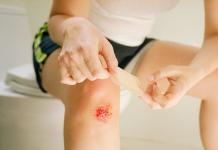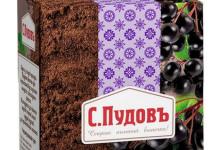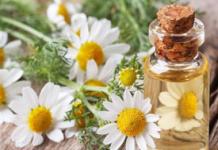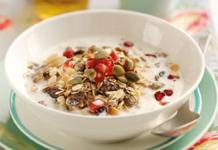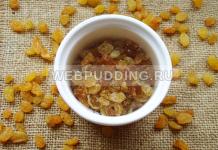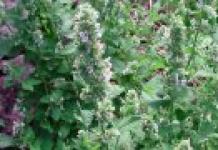Good day, dear readers!
In today's article, we will consider with you such a wonderful medicinal plant as chamomile, as well as its beneficial properties and contraindications, composition, and treatment with chamomile. So…
Chamomile- a genus of perennial flowering plants that belong to the Asteraceae or Asteraceae family.
The scientific name of the genus - Matricaria, which means "uterine grass", comes from the Latin word matrix - uterus. It got its name due to the use of the plant in the treatment.
The most famous species is chamomile, which is used for medicinal and cosmetic purposes. We will talk about this type of chamomile in today's article.
Chamomile blooms from May to September, the fruits ripen from July. To distinguish medicinal chamomile from other types of chamomile, you should look at the receptacle; in medicinal chamomile it is protruding, elongated-conical, hollow inside.
Chamomile is also called- mother grass, camila, blush, peeled chamomile, morgun, German chamomile, Romanov grass.
 The healing properties of chamomile are largely determined by the abundant amount in its composition, and other substances, thanks to which doctors and traditional healers use this gift of nature in the treatment of almost all diseases of the body.
The healing properties of chamomile are largely determined by the abundant amount in its composition, and other substances, thanks to which doctors and traditional healers use this gift of nature in the treatment of almost all diseases of the body.
The composition of chamomile pharmacy (medicinal) includes the following substances:
- vitamins -, and carotene;
- essential oil (0.2-0.8%) in inflorescences;
- biologically active substances - flavonoids, chamazulene, derivatives of apigenin, isorhamnetin, quercetin, kaempferol and luteolin, matricin, matrikarin, phytosterols, coumarins, gum;
- organic acids - caprylic, isovaleric, salicylic and phenolcarboxylic acids;
- sesquiterpene lactones;
- other substances - mucus, bitterness, polyacetylenes and many other macro- and microelements.
Medicinal properties of chamomile
In medicine, chamomile is used for many diseases, for example:
- (and, intestinal inflammation);
- diseases of the urinary organs;
- with increased acidity of gastric juice;
- painful, menstrual irregularities;
- inflammation of the female genital organs;
- increased excitability;
- children's diarrhea (which is accompanied by colic-like pain and swelling), can be used no earlier than 2 years of age.
In addition, chamomile has the following properties:
- improves appetite;
- strengthens the immune system;
- antimicrobial;
- disinfectant;
- antimicrobial;
- antiallergic;
- anti-inflammatory;
- astringent;
- hemostatic;
- antispasmodic;
- sedative;
- anticonvulsant;
- diaphoretic;
- choleretic;
- diuretic.
Harm chamomile
No matter how useful chamomile is, it can also harm the body, for example, if a person has an individual intolerance, or.
Chamomile is not recommended to be combined with chemical sedatives, especially without consulting a doctor. Also, you should not drink it without measure, here the principle “the more the better” can only do harm, the analgesic effect of chamomile can lead to hemorrhages if used together with pharmacology.
If you have allergies to certain foods or spring hay fever, because the pollen in dried chamomile flowers can cause allergic reactions.
Also, chamomile should not be used with drugs such as Furosemide and its analogues. The combination of several diuretics at the same time can provoke.
Chamomile Contraindications
Chamomile is contraindicated in:
- anacid gastritis (arising against the background of the absence of hydrochloric acid);
- stomach ulcer (caused by anacid gastritis);
- mental disorders;
- profuse painful menstruation;
- tendency to diarrhea;
- pregnancy.
For the treatment of diseases of the kidneys and bladder, chamomile preparations are allowed only under the strict supervision of a doctor with great care.
Chamomile and homeopathic medicines are not compatible, since the action of homeopathic medicines is neutralized by chamomile.
 Traditional healers recommend drinking a decoction of chamomile as an anti-inflammatory, antiseptic, antispasmodic and diaphoretic. In addition, it can be drunk with bloating, intestinal cramps and diarrhea.
Traditional healers recommend drinking a decoction of chamomile as an anti-inflammatory, antiseptic, antispasmodic and diaphoretic. In addition, it can be drunk with bloating, intestinal cramps and diarrhea.
In addition to drinking, the decoction is used as a rinse, lotion, enema, or for taking a bath.
How to brew chamomile? Consider ways to brew chamomile, but before using folk remedies, be sure to consult your doctor!
Chamomile tea. Add 1 teaspoon of chamomile flowers to a glass and pour boiling water over the plant, leave for 10 minutes to infuse and cool, after which, the infusion can be consumed, but in a warm form. To improve the taste, you can add sugar here or.
Chamomile tea is a wonderful folk remedy against inflammatory diseases of the digestive tract, stomach cramps, and delayed menstruation. To gently remove sand and stones from the gallbladder and its pathways, add a little butter to chamomile tea (at the tip of a teaspoon).
Decoction of chamomile flowers. Pour into an enamel bowl 4 tbsp. spoons of chamomile flowers, pour them with a glass of boiling water, cover and cook in a water bath for about 30 minutes. Next, leave the product to cool, for 15-20 minutes, strain it and wring it out. After that, add a little more boiling water to the broth so that it becomes a glass again in quantity, and drink the remedy after meals, half a glass, 2-3 times a day.
Chamomile bath. The following remedy helps in the treatment -, and other types, as well as cleanse the skin of various. To prepare it, you need to pour 20 g of chamomile into a saucepan and pour them with 1 liter of water, put on a small fire and boil for 10 minutes, then cool, strain and add to the bathroom.
This tool can also be used for bathing babies.
 Important!
Before using chamomile, be sure to consult your doctor!
Important!
Before using chamomile, be sure to consult your doctor!
In some cases, during treatment with chamomile preparations, a decrease in muscle tone and a general depression of the nervous system may appear. In this case, you should reduce the dosage or stop taking chamomile.
Also, if you experience outbursts of irritability and unreasonable anger while taking chamomile or chamomile preparations, then stop taking it.
With the right dosage, chamomile will not do any harm if there are no contraindications to taking it. But, you should not use chamomile for a long time. Some people have been drinking chamomile tea in place of regular tea for years, believing it to be beneficial, but this is far from the case. With such uncontrolled long-term use of medicinal chamomile, dizziness, nervous anxiety and conjunctivitis may occur.
Video about chamomile
That's probably all, but we are wondering, dear readers, maybe you have your own experience of using chamomile for medicinal purposes? Share your knowledge in the comments, and perhaps your recipe will be the best and most effective medicine for someone!
Chamomile is a medicinal plant that has long been known for its beneficial properties and a small number of contraindications. Of particular medicinal value is the essential oil contained in the inflorescence baskets. This odorous substance relieves inflammation, has a tanning and weak antimicrobial effect. Chamomile treatment is used in gynecology, urology, and in diseases of the gastrointestinal tract. Outwardly - in the form of rinses and lotions, inside - traditional chamomile tea.
General information
Chamomile is a perennial flowering plant that belongs to the Astrov genus. This is a wild flower, widespread in Eurasia and North America. The scientific name of chamomile (Matricaria) in Latin means "uterine herb". The plant received this name due to its frequent use in the gynecological field.
The plant consists of a low stem and narrow leaves. The inflorescence is represented by a cylindrical basket up to 2 cm in diameter. These are healing flowers that have a yellow center and white petals. In medicinal samples, they are located in a horizontal plane or lowered to the bottom.
Chemical composition
The beneficial properties of chamomile are explained by the content in it of a large number of chemicals that have a beneficial effect on the body. The plant contains B vitamins, ascorbic acid and carotene. Most of the beneficial compounds are concentrated in the flowers.
Chamomile essential oil contains more than 40 substances valuable for health. One of them is chamazulene, which turns the volatile liquid blue. It is not produced by the plant, but is released during the processing of chamomile flowers with steam and chemical compounds.
The inflorescences contain:
- flavonoids, bisabolol and its derivatives;
- terpene, cadinene;
- sesquiterpene alcohols;
- organic acids (nonyl, isovaleric, caprylic).
Thanks to them, chamomile has healing properties - anti-inflammatory, antihistamine, regenerative. Apigenin, coumarins, quercimerythrin produce an antispasmodic effect. Bitterness, mucus, gums, fatty acid glycerides, micro and macro elements, nicotinic and salicylic acid - complete the list of active substances that make up the medicinal plant.

Chamomile properties
Since ancient times, the flower has been popular in folk medicine, in the medical environment for a long time they did not recognize its therapeutic effect. Doubts were dispelled when, after long research, the therapeutic effect of the plant was proven and it began to be attributed to medicinal herbs. Today, chamomile and preparations made from it are actively prescribed for the treatment of various organs and systems.
The most valuable properties of the plant include:
- anti-inflammatory;
- antiseptic;
- diaphoretic;
- soothing;
- antiallergic.
Chamomile enhances the production of bile and gastric juice, so it is prescribed to improve the digestive process. It prevents heartburn, nausea, improves appetite. It helps women with pain during menstruation, heavy bleeding from the uterus and during menopause.
Chamazulene has a calming effect on the nervous system, improves brain activity, improves mood, eliminates muscle spasms, heals and relieves pain. Essential oil stops inflammation, kills putrefactive bacteria, and eliminates unpleasant odors.
When applied externally, chamomile relieves swelling, skin irritation with dermatitis, insect bites. The effectiveness of a medicinal plant for the treatment of boils, burns, frostbite, and long-term non-healing wounds has been proven. The antihistamine effect of the medicinal flower is used in the treatment of bronchial asthma, allergic reactions.
The medicinal plant is often used in the pharmaceutical industry. Due to the healing properties of chamomile, preparations based on it have the following effect:
- diaphoretic;
- choleretic;
- laxative;
- antispasmodic;
- diuretic;
- expectorant;
- anticonvulsant.
Regular consumption of chamomile has a positive effect on the state of the cardiovascular system. It is prescribed for diseases of the kidneys and urinary tract, the musculoskeletal and ligamentous apparatus, the prostate gland, the respiratory system, benign neoplasms and oncology.
With colds, chamomile will lower the temperature, stop inflammation, and strengthen the body's immune defenses. The plant is able to thin phlegm and clear the respiratory tract. Chamomile tea increases efficiency, improves the quality of sleep, with its help you can forget about insomnia.
Chamomile is widely used in cosmetology. Its extract is added to shampoos, creams, soaps for all types of skin and hair. This is due to the beneficial properties due to which chamomile moisturizes and softens the skin, soothes itching and irritation, eliminates peeling, and regulates the sebaceous glands.
Chamomile toothpaste has a beneficial effect on the health of teeth and oral mucosa. It eliminates inflammation on the gums, reduces bleeding, improves the quality of regeneration processes, and helps fight bad breath.
In children's practice, chamomile is used to bathe babies. Broth wipe the folds on the baby's body, wash the eyes to prevent inflammation of the conjunctiva. To improve the adaptation of the gastrointestinal tract in the first months of life, the child is given to drink chamomile tea. It prevents bloating, eliminates colic, normalizes the digestive process, soothes and promotes fast falling asleep.

Indications for use
Chamomile is used to treat various diseases:
| Organs and systems | Diseases and their symptoms |
| Gastrointestinal tract | Chamomile infusion is used for colitis, gastritis, enteritis, gastric ulcer and duodenal ulcer, pancreatitis and intestinal infection (dysentery). It improves intestinal motility, treats flatulence, diarrhea, and eliminates spasms. Chamomile is included in the phytocollection to eliminate heartburn and colicky pains. |
| Ophthalmology | Decoction wipe the inflamed mucous membrane of the eye caused by an infection or an allergic irritant (conjunctivitis) |
| Spine, joints | Chamomile ointment is used to relieve radiculitis, baths for the treatment of gout. Herbal preparations for arthritis, arthrosis, osteochondrosis |
| The cardiovascular system | Chamomile infusion with vegetable juices is used for phlebitis, arrhythmia, atherosclerosis. If honey is added to a healing drink, the remedy increases blood pressure and raises vitality. Herbal collection with the addition of chamomile is prescribed for hypertension and vegetovascular dystonia |
| Liver and bile ducts | Chamomile infusion is drunk to improve the outflow of bile, eliminate stagnant processes. With the help of herbal teas, hepatitis, cirrhosis of the liver, cholecystitis, inflammation of the bile ducts can be treated. |
| urinary system | A decoction reduces inflammation in cystitis, helps with urolithiasis |
| Skin covering | Outwardly, chamomile is prescribed for skin diseases, acne, furunculosis, small abscesses, ulcers. The decoction heals deep cracks in the feet and prevents keratinization of the skin. Herbal preparations are effective for eczema, neurodermatitis, psoriasis, vitiligo, chemical burns and frostbite. |
| Nervous system | Chamomile infusion with cumin and rosemary eliminates excitability, neurosis, insomnia |
| reproductive system | In women with menopause, pain during menstruation, inflammation of the uterus and its appendages, as well as with colpitis, vaginitis, thrush. For men, chamomile is prescribed for adenoma or inflammation of the prostate gland. |
| Endocrine system | Medicinal preparations with chamomile are indicated for patients with type 1 and type 2 diabetes |
| Respiratory system | Tonsillitis, laryngitis, bronchitis is an indication for inhalation with a solution of chamomile. In combination with the main therapy, a medicinal plant helps to stop an attack of bronchial asthma. |
| Tumor-like growths | Polyps in the nasal cavity, uterine cancer, malignant tumors in the spleen |
In the presence of hemorrhoids, proctologists advise daily enemas with chamomile, and in cases of exacerbation, take the infusion orally or use it in a solution for poultices.

Contraindications
Despite the benefits of chamomile, a course of herbal medicine should be started after consulting a medical specialist. The doctor will conduct a preliminary diagnosis, assess the state of health. Allergic reactions to a plant are rare, most often it can appear on another component that is part of the phytocollection.
There are few contraindications to the use of chamomile:
- individual intolerance;
- hypersensitivity to the drug;
- chronic diseases in the period of exacerbation;
- kidney, heart, liver failure;
- children under 12 years of age are not allowed to take oral medications.
For women during pregnancy and lactation, phytotherapy is possible only after the permission of the doctor. But, even after receiving the approval of a specialist, it is impossible to use chamomile tea as a daily refreshing drink.
Side effect
Excessive use of a medicinal plant causes nausea, bloating, stool disorder (diarrhea), headaches and dizziness, cough, nervous tension, and a hoarse voice. In women, an overdose of chamomile provokes pain during menstruation. Abuse of essential oil provokes muscle weakness. All symptoms of side effects disappear after the abolition of herbal remedies.

Application methods
Most useful in chamomile are chamazulene and matricin. It is possible to isolate them from inflorescences only by special processing of raw materials. Most often used in the preparation of a decoction or infusion. The medicinal plant is used both separately and as part of herbal preparations. The presence of additional components enhances the healing properties of the flower, so phyto-collections are recommended by representatives of traditional and traditional medicine.
In various directions, there are several forms of chamomile-based remedies:
- Decoctions - for joint pain, trigeminal neuralgia, minor injuries, convulsions, neuroses.
- Infusions are recommended to be used for inflammation. As a hemostatic, choleretic, diaphoretic, diuretic, sedative.
- Baths and enemas have anti-inflammatory, astringent and antiseptic effects.
- Rinsing - for diseases of the oral cavity and upper respiratory tract.
- Lotions - used for acne, severe itching, non-healing wounds.
Most dosage forms can be prepared at home using purchased or self-prepared components.
Infusion
The liquid form in the form of an aqueous extract from medicinal chamomile can be prepared in several ways:
- Dried flowers in the amount of 1 tablespoon pour a glass of boiling water. Insist under a tightly closed lid. After 30 minutes, the infusion is ready for use.
- Raw materials (5 g) pour into a container, pour cool water, let stand for 12 hours. With this method of preparation, all the beneficial properties of chamomile are preserved, but not all healing substances pass into the infusion.
- Grind 1 tablespoon of raw materials, pour water (200 ml) at room temperature. Keep in a water bath for 20 minutes, remove from heat, until ready to insist another 40 minutes.
Inside, the infusion is used as an anti-inflammatory, antibacterial, antispasmodic and sedative. If there is no allergy, it is useful to add honey to the product. You need to drink the infusion freshly prepared, it can be stored in the refrigerator for 3 days.
With reddening of the throat, periodontal disease, pathologies of the oral cavity, the infusion is used for rinsing. It is effective for excessive smoking, drinking strong coffee, strong emotional and mental stress. Chamomile infusion is good for bathing procedures, for greater benefit, you can add St. John's wort, mint, linden, thyme to it.

Decoction
An aqueous extract of chamomile is obtained by heat treatment. To preserve the maximum number of useful properties, it is recommended to cook the decoction in a water bath, avoiding open fire. To prepare, you will need a tablespoon of raw chamomile and a glass of water.
The mixture is heated for 30-40 minutes. The longer the time the decoction is on fire, the greater the concentration of healing compounds in it will turn out. 10 minutes after completion of heating, the solution is filtered, topped up with water until the initial volume is obtained.
Chamomile tea and fees
It has been proven that in combination with other herbs, the healing properties of chamomile are enhanced. Therefore, it is often included in various fees. Doctors advise to give preference to ready-made fees, which are sold in pharmacies. It is recommended to mix herbs on your own strictly according to the prescription, and apply after the permission of the doctor in order to avoid negative side effects.
Chamomile tea can be called a universal remedy. It is indispensable for women's problems, diseases of the gastrointestinal tract, respiratory organs, helps to cope with colds and strengthen the immune system. Preparing it is simple: pour a bag of dried raw materials with a glass of hot water, leave to infuse for 10 minutes. Additionally, you can add milk, honey or berries to the healing drink.
Tincture
Dosage form on alcohol does not provide for heat treatment and is prepared as follows:
- grind chamomile flowers, pour into a glass container, filling it 1/5;
- pour vodka or diluted medical alcohol;
- close the lid, put in a dark cool place for 8 days;
- strain, pour into another dark glass container.
With proper storage, chamomile tincture does not lose its therapeutic properties for 2 years. This is a potent dosage form that can be taken orally only after the dosage has been prescribed by a doctor. The duration of the course should not exceed 14 days.

Baths
Inflammatory skin lesions, allergic rashes, arthralgia, neurosis, convulsions are indications for the appointment of a bath with chamomile. To prepare it, the required amount of raw materials (500 g) is poured with water, heated in a water bath for 10 minutes. After straining, pour into a bath filled with water. Sometimes instead of a decoction, you can use 2-3 drops of essential oil.
Microclysters
This form helps with hemorrhoids, gynecological diseases, prostatitis, and serves as an addition to the main treatment. Microclysters are done in the evening, before going to bed. To prepare the solution, take 1 teaspoon of raw materials, pour 50 ml of boiling water. After 30 minutes, filter, apply, cooling to body temperature.
Compresses and poultices
As a basis for external use, infusion and decoction are used. The fabric folded in several layers is moistened in a healing solution, applied to the sore spot. Fix with a bandage or plastic wrap. This is how a compress is made.
For a poultice, 50 g of chopped chamomile is poured with water, heated for 5 minutes in a water bath. The raw material is squeezed out, applied hot to the affected area, kept until it cools. Used to treat diseased joints, muscles, varicose veins.
douching
Washing the vagina is carried out according to the following indications:
- inflammation of the female genital organs;
- cystitis, candidiasis;
- cervical erosion.
The solution is prepared from 1 teaspoon of flowers and 200 ml of water. Raw materials are poured with boiling water, left to brew for half an hour. Douching can be done once a day for a week. Despite the beneficial properties of chamomile, this procedure has contraindications:
- exacerbation of inflammation;
- pregnancy;
- the first month after gynecological operations, delivery.
With caution, douching is prescribed for women after 40 years of age, who have dry mucous membranes.

Use in cosmetology
For cosmetic purposes, chamomile is used in the following conditions:
| Problem | Recipe |
| Freckles | Chamomile mask will help whiten the skin of the face. To do this, brew 20 g of flowers with 0.5 liters of boiling water. After 25 minutes, squeeze the juice of 2 lemons into the infusion, add 300 ml of low-fat sour cream. Keep the mask on your face for about an hour, rinse with warm water |
| Redness | Moisten a gauze cloth in an infusion of chamomile with honey, apply to the irritated area. Leave on for 30 minutes, change towels as they dry |
| Acne | Take chamomile and celandine, mix in proportions 2:1. Collection pour boiling water, insist 12 hours. Wipe areas with acne up to 5 times a day |
| Brittle and dry hair | The rinse solution is prepared from 20 g of chamomile, 500 ml of boiling water. The mixture is infused for 30 minutes, add the yolk, mix thoroughly. The product is applied to the hair, after 10 minutes, rinse with plenty of water. The procedure is repeated every other day |
If you believe the reviews on the sites, cosmetic products with chamomile are very popular due to their availability and good effect.
Chamomile oil
Most often, an oily liquid with a pleasant grassy smell is used to deodorize the air. A few drops drip into the aroma lamp and breathe in the healing air for 20 minutes before going to bed.
To increase immunity, treat pathologies of the gastrointestinal tract, with poor appetite, chamomile oil is taken orally. It is useful to do this with honey: 2 drops of oil are added to 1 tablespoon of beekeeping product. It is forbidden for pregnant women and children under 6 years of age, the rest can be drunk in the morning and evening for 7 days.

How to prepare and store
For self-preparation of funds, doctors advise using the herb that is sold in a pharmacy. If you collect raw material yourself, you need to do this away from highways, industrial enterprises. Additionally, you need to learn how to distinguish pharmacy chamomile from similar flowers without medicinal properties.
Collection
In nature, chamomile blooms from May to September, but it is better to collect inflorescences at the beginning of the season. Flowers that have just begun to bloom are well suited. In such baskets, the middle is not smooth, but convex. The inner petals are arranged horizontally and directed upwards. Properly prepared raw materials contain many useful substances. Unripe flowers will not fall off during drying and storage.
Chamomile can not be collected in wet weather, after rain and in the morning with dew. The best time to collect is from 8 am to 5 pm. The plant does not have to be uprooted, it is better to cut the flowers with scissors and put them in boxes with low sides. Leaves, sand, stems, inflorescences affected by the fungus should not be allowed to enter the raw material.
Drying
Dry raw materials in a well-ventilated area or outdoors in hot weather. Flowers are poured onto the surface with a layer of no more than 5 cm and placed in the shade. When exposed to direct sunlight, chamomile essential oil is destroyed. The raw material must be well dried, for this it must be periodically turned over.

Storage
Store dry chamomile in a clean, dry container - in glass or metal jars, cardboard boxes. The container must be tightly closed. Dried raw materials are placed in dark rooms with good ventilation. With proper storage conditions, chamomile retains its properties for 2 years.
Release form and price
For ease of use and preservation of useful properties, chamomile is produced in the form of:
- liquid tincture, extract capsules;
- chamomile oil in bottles;
- packed in disposable bags;
- in the form of a scattering.
The average cost of chamomile in filter bags is 83 rubles, bulk packaging is 78 rubles, and essential oil is 292 rubles. You can buy the drug at any pharmacy without a doctor's prescription.
 Shy Russian fields - chamomile. An amazing plant: with absolute unpretentiousness and wide distribution, it has colossal medicinal properties.
Shy Russian fields - chamomile. An amazing plant: with absolute unpretentiousness and wide distribution, it has colossal medicinal properties.
It is considered an excellent remedy for a huge number of ailments.
Dried chamomile is probably in almost every family, and if someone still doesn’t have it, then it must be purchased and always on hand, since this is the number one remedy for all sorts of health problems, both in adults and in children. .
pharmaceutical camomile
Chamomile is just the golden combination of cost and effectiveness that many are looking for in modern medicines. Moreover, chamomile can and should be harvested independently during its flowering season: May, June, July.
A walk in the fresh air, far from the dust and smog of cities, will bring a lot of pleasure and benefits, including in the form of a harvested chamomile crop.
You only need to pluck the inflorescences of the plant, and then simply spread it in one layer on any suitable tray or baking sheet and dry it in a ventilated, shaded place - on a veranda, balcony, in a clean outbuilding. 
Ready raw materials are put into paper bags or boxes and used until the next season. The shelf life of dried chamomile is 2 years, so if you prepare it for future use once, you can use it for a couple of years.
There are many legends and stories about chamomile. There are many varieties of this herb, but from a medical point of view, only chamomile or medicinal chamomile is of interest.
She has small unsightly flowers, a peculiar aroma, with a noticeable bitterness. When the inflorescence is cut across, a hollow dome is observed inside - this is the main difference between medicinal chamomile and decorative chamomile.
Chamomile is a close relative of such beauties as gerbera, chrysanthemum, aster, only more unpretentious and hardy. It grows in the middle lane everywhere.
It is an annual plant, sprouts from last year's fallen seeds in early spring, develops rapidly and blooms in the second half of May.
Flowering is long - up to three months, so there is always plenty of time for those who wish to harvest chamomile.
The chemical composition of pharmaceutical chamomile
The most interesting thing about chamomile is its chemical composition.
Nutritional value and calorie content are absolutely not essential things, since it is used only for the preparation of medicinal decoctions and infusions, as well as delicious tea, to which good honey serves as an excellent addition.
Herbalists advise not to use the whole chamomile plant as the highest concentration of bioactive components is observed only in flowers.
Chamomile is rich in:
quercetin, apigenin and luteolin are famous bioflavonoids;
organic acids - caprylic, salicillic, antimisic, isovaleric;
sesquiterpenoids;
valuable essential oil.
The richest composition of chamomile determines the breadth of its applicability. They are effective in the treatment of both the simplest ailments, and serious diseases with a complicated course.
Chamomile pharmacy - useful properties
It is almost impossible to list all the cases in which chamomile can be used, it is easier to say one word: everything. That is, the moderate use of chamomile-based preparations will be a good help in the fight against all diseases.
 In order to understand in what cases it should be used, we recall main pharmacological properties of chamomile:
In order to understand in what cases it should be used, we recall main pharmacological properties of chamomile:
anti-inflammatory;
antiallergic;
antibacterial;
bile and diaphoretic;
antimicrobial;
sedative;
antiseptic;
analgesic;
rejuvenating;
regenerative;
healing.
Based on the listed properties, a list of conditions follows in which chamomile will be a reliable healer or an essential assistant when used as part of complex therapy.
1. Quickly heals any skin damage, including infected ones: cuts, burns, dermatitis, various rashes - allergies, chickenpox.
2. Has a pronounced antihistamine effect. Chamomile infusions can be used topically and orally to treat allergies.
3. Helps to cope with colds and viral diseases. Tea reduces elevated body temperature, enhances the body's immune response, helps to reduce intoxication.
4. Used as an antitussive.
5. Gargling with chamomile infusion relieves sore throat, various rashes in the oral cavity - stomatitis, erosion.
6.Chamomile is a recognized remedy for many gynecological diseases.. Douching and washing help with erosion, vaginitis, thrush and other diseases. 
7. A decoction or infusion soothes the stomach, promotes full digestion, relieves reflux, heartburn, gastritis. Chamomile infusion in cases of gastritis should be taken 30 minutes before a meal, and for reflux and heartburn 30 minutes after a meal.
8. Stimulates the separation of bile, supports the work of the gallbladder and liver.
9. It has a mild sedative effect, helps adults and children fall asleep faster and sleep better, improves mood, is used as an anti-stress agent.
11. Thanks to its antiviral activity, it can speed up recovery from ARVI and influenza.
12. Has an antirheumatic effect.
13. Relieves pain, relieves all kinds of inflammation.
14. Enriches the body with minerals.
15. Used for all gastric discomforts, removes bloating.
16. Cosmetologists use chamomile for the treatment of hair, nails, to improve the appearance of the skin, as part of anti-aging products. Chamomile also treats acne in adolescents, furunculosis, acne.
17. Used for bathing babies to keep their delicate skin healthy and protected.
 18. Chamomile improves the condition of hepatitis, cholecystitis, pancreatitis, colitis.
18. Chamomile improves the condition of hepatitis, cholecystitis, pancreatitis, colitis.
19. As an aid, it is prescribed for rheumatism.
20. Chamomile and essential oil from it are suitable for therapeutic inhalations, cosmetic steam baths.
21.Chamomile oil, as an aroma remedy, reduces the strength of neurosis, anxiety attacks, manifestations of vegetative-vascular dystonia, PMS, increased irritability. Eliminates sleep problems caused by nervous tension.
It is clear that chamomile is a true ally in the fight against any common disease and it is always good to have it in the first aid kit, so that if necessary, you can immediately use it and prevent complications.
Chamomile pharmacy - contraindications
A fly in the ointment in a barrel of honey is contraindications for chamomile. There are not many of them, but they are, like any other medicinal plant.
- Anacid gastritis.
- Mental disorders.
- Pathology of the kidneys.
- Pregnancy (here with great care).
- Abundant menses.
There is also a personal intolerance to this plant. Also, chamomile should not be used simultaneously with homeopathic remedies, since it neutralizes the effect of the latter. Be healthy.
For external use, and alcohol tincture has very limited applicability precisely because of the presence of alcohol in its composition, the decoction is used both internally and externally, both in adults and in children. Of course, he has certain limitations, but there are not so many of them. At the same time, chamomile decoction really helps with a variety of diseases precisely due to the very wide spectrum of chamomile activity.
Raw materials for the preparation of chamomile decoction are dried flowers with peduncles.
At the same time, chamomile decoction is often used unreasonably for such diseases and syndromes in which it is not able to help. Such use of this remedy is not only useless, but can be harmful, since chamomile can cause some side effects.
Let's see what diseases most often try to use chamomile decoction, and see what it helps with, when it is really useful, and when its use does not make sense and if it works, then only in placebo mode.
Does a decoction of chamomile help with ARVI, including the flu?
With influenza and other acute respiratory viral infections, a decoction of chamomile is useful for relieving sore throats and relieving the symptoms of a runny nose. To do this, it is used only locally:
- For sore throats, chamomile decoction is used to rinse the throat. These procedures help to reduce inflammation and sore throat, and their faster completion. They do not give an instant result, but when compared with treatment without such rinses, they can reduce the duration of the pain syndrome by 1-2 days and, in general, alleviate the patient's condition;
- To relieve a runny nose, the nose is washed with a decoction. This allows some of the mucus to be washed out and facilitates its natural flow, helps to moisten the surface of the inflamed mucosa and reduce inflammation. In some cases, with properly performed lavages, a patient with ARVI does not have to drip vasoconstrictors into the nose;
- To reduce inflammation in the upper respiratory tract, inhalations with chamomile decoction are carried out. However, they do not make much sense, since, in fact, the components of chamomile do not penetrate deeper than the nasopharynx, and it is easier to introduce them here, either by simply dropping the decoction into the nose (for young children) or washing it (for adults). Doing inhalation with chamomile decoction with a compressor, ultrasonic inhaler, or nebulizer is strictly prohibited by the instructions for using these devices.

Such inhalations must be carried out with great care because of the risk of scalding and because they are contraindicated in bacterial infections.
At the same time, with the flu and other acute respiratory viral infections, it makes no sense to drink a decoction of chamomile. When it enters the digestive tract, it does not cause any effect that can be useful in ARVI. However, it is known that chamomile can provoke diarrhea - a very common disorder in some types of viral infections. In particular, with rotavirus infection, it is diarrhea that is the most terrible syndrome, from which a large number of children die every year around the world. Risking its development for the sake of taking chamomile is completely pointless.

A rotavirus virion capable of causing an infection that will manifest first as a digestive disorder and then as a respiratory syndrome.
There is an opinion that chamomile decoction can help reduce the temperature. This assumption is not confirmed in any way; such properties of chamomile are not indicated in pharmacopoeias. To some extent, simply drinking liquids contributes to the normal regulation of temperature during the heat, but ordinary tea and pure water will equally cope with this task. There is no point in forcibly watering a child with not the most pleasant tasting chamomile decoction.
The use of a decoction for prostatitis
Theoretically, a decoction of chamomile can reduce prostate inflammation. Such use of it is practically the only specific indication for taking chamomile decoction for men. This effect is more likely if enemas with chamomile and parallel prostate massage are performed for this purpose, the same result is less likely if chamomile is simply taken internally for this purpose.

There is practically no information about the effectiveness of the treatment of prostatitis (even symptomatic) with chamomile decoction.
At the same time, the intake of chamomile decoction does not affect prostatitis itself and its course. It is impossible to completely cure the disease only with this remedy - it only allows to alleviate the symptoms. There is no evidence base for the treatment of prostatitis with chamomile. Therefore, the remedy for this disease can only be used in parallel with the main treatment and only as directed by the doctor.
When vomiting
With nausea and vomiting, taking a decoction of chamomile is not recommended. By itself, it has an unpleasant taste and in large quantities can provoke a gag reflex, so it will definitely not improve the patient's condition.
Does chamomile tea help with heartburn and can it be used for GERD?
Chamomile decoction does not help with heartburn. There is no known mechanism by which chamomile could affect lower esophageal sphincter activity or gastric acidity.

At the same time, to some extent, chamomile decoction, when taken orally, normalizes the functioning of the muscles of the stomach and intestines, due to which the general condition of a patient with gastroesophageal reflux disease can be alleviated. Heartburn will not go away completely, but the severity of GERD symptoms with it may decrease.
Inflammation of the female genital organs
The use of chamomile for vulvitis, vaginitis, endocervicitis, genital herpes and other diseases of the female genital organs is very widespread. As a rule, for this purpose, douching or washing is carried out with a decoction of chamomile.
Statistics show that with such diseases, chamomile decoction has practically no effect on the course of the disease and on the general condition of the woman. Moreover, douching them can contribute to the introduction of infection from the vagina into the uterus and subsequent inflammation of the uterus. At the same time, douching itself increases the risk of injury to the vaginal epithelium, disrupts the microbiological background here and is one of the risk factors for the development of oncological pathologies.

With cystitis and various gynecological diseases, chamomile can only be used inside, and it is strongly not recommended to douche.
To some extent, symptomatic therapy of female diseases is possible, including those associated with inflammation and accompanied by itching and pain in intimate places. If itching develops precisely on the external genital organs, washing them with a decoction of chamomile can reduce the severity of sensations and generally improve the patient's condition. In these cases, the decoction is really useful. However, it is impossible to completely cure any such disease with the help of chamomile, and therefore its decoction is used only as a means for symptomatic therapy.
Definitely, chamomile decoction will not help with diseases associated with various neoplasms. For example, it makes no sense to take it with an ovarian cyst, with cervical dysplasia and with various benign formations - chamomile does not affect their growth in any way.
For the same reason, chamomile does not help with mastopathy, also associated with the appearance of cysts, but not in the genitals, but in the mammary glands.
Diseases of the gastrointestinal tract
Diseases of the gastrointestinal tract, accompanied by pain in the abdomen and caused by inflammation, ulcers or muscle spasms are the main indications for the use of chamomile decoction.
For example, WHO indicates the symptomatic treatment of gastrointestinal diseases and digestive disorders as the main indication for the use of chamomile decoction orally or in the form of enemas, the feasibility of which is confirmed by special studies.

Regenerated epithelium of the gastric mucosa with gastritis - when taking chamomile, its regeneration and restoration of mucosal function is accelerated.
So, chamomile is used for:
- Gastritis (including with an ulcer);
- Colitis, including with its nonspecific ulcerative form (NUC);
- enteritis;
- Dyspepsia;
- bloating;
- flatulence.
With these diseases, taking a decoction helps to relieve pain in the abdomen, remove gases, normalize muscle contractions and eliminate spasms, cleanse the intestines. It is taken as an adjuvant in the complex therapy of a disease.
As a rule, with gastritis, bloating, dyspepsia, the decoction is taken orally, with colitis, enemas are made with it.
Chamomile decoction for gout
With gout, a decoction of chamomile is practically useless. There is no reason to believe that foot baths with it, lotions or ingestion could affect the deposition of salts in gout or in any way weaken the severity of its attacks.

It is unlikely that such manifestations can be weakened or completely eliminated with the help of chamomile.
Cholelithiasis
The feasibility of taking chamomile decoction for cholelithiasis is a matter of debate.
On the one hand, chamomile is known for its ability to cause a slight choleretic effect. On the other hand, chamomile does not have a pronounced effect on the course and symptoms of gallstone disease. There are no known cases when the use of this remedy would significantly improve the patient's condition or would contribute to the dissolution of stones in the gallbladder.

Gallstone disease is one of the indications for taking chamomile in traditional medicine, although in fact there is no evidence of the effectiveness of chamomile decoction with it.
In any case, today it is reliably known that sandy immortelle is many times superior to chamomile in terms of choleretic effect and benefit in cholelithiasis. Taking chamomile decoction for this disease cannot be considered appropriate.
Does chamomile help with delayed periods?
It is reliably known that chamomile is able to stimulate the activity of the muscles of the uterus. Due to this, her decoction is often drunk to hasten the onset of menstruation, especially when they are delayed.
However, this property must be used very carefully. In some cases, a delay in the onset of menstruation can be caused by pregnancy, and stimulation of the uterus with chamomile can lead to miscarriage. Sometimes even the miscarriage itself at too early a time is confused with heavy periods. Therefore, when taking chamomile decoction to accelerate the onset of menstruation, a woman needs to make sure in advance that she is not pregnant.
The effect of decoction on the condition of a woman with menopause
With a severe menopause, a woman may really need a decoction of chamomile. Providing a mild sedative, calming, relaxing effect, it helps to relieve the symptoms of "hot flashes" - headaches, pressure surges, emotional outbursts.
In the photo - the same decoction that can be drunk 1-2 times a day instead of tea:

At the same time, the effect of chamomile on the nervous system is not as pronounced as, for example, that of St. John's wort, and therefore, when deciding whether to take auxiliary traditional medicine, a woman or her doctor must evaluate the severity and severity of symptoms in order to choose the most suitable drug correctly.
The benefits of chamomile decoction in cosmetology
Chamomile is widely used in both clinical and aesthetic cosmetology.
In particular, its decoction has a pronounced anti-inflammatory effect in acne, excessive sweating, the appearance of characteristic black spots on the skin. To combat these problems, masks and lotions with chamomile are used.
For example, in the photo - a typical problem of "black dots", which can partly be solved through the regular use of lotions and washes with chamomile:

Also, a decoction of chamomile is used to wash the hair - it provides an easy staining of them in a yellowish color. Also known is a recipe for a remedy made from egg yolk, honey, almond oil and chamomile decoction, in which a lotion is moistened and applied to the face for 20-25 minutes. After such a procedure, the skin becomes matte and smoother.
At the same time, with swelling on the face or different parts of the body, chamomile broth practically does not help. Some diuretic effect of chamomile is supposed, but it is weakly expressed and in practice chamomile broth does not allow either to get rid of edema or even reduce their severity.
Dermatological diseases
The anti-inflammatory activity of chamomile is widely used in the treatment of various skin diseases. Among them:
- Dermatitis;
- eczema;
- Couperosis of various etiologies;
- Rosacea
- burns;
- Allergic rashes.

The main ability of chamomile used in such syndromes is anti-inflammatory, which reduces the severity and soreness of the rash.
With them, lotions or simple rubbing with chamomile of inflamed or damaged skin areas helps to reduce inflammation and its manifestations, as well as faster regeneration of damaged tissues. A decoction is also useful for reducing the severity of itching.
On a note
When treating allergic rashes with chamomile decoction, great care must be taken. Chamomile itself can cause an allergy or enhance an already developed reaction. Therefore, it is possible to lubricate the rashes with its decoction from small areas and applying small amounts of the product. If the decoction does not increase the allergy, you can gradually increase the intensity of the treatment of the rash with it.
To some extent, a decoction of chamomile helps to alleviate the manifestations of diathesis if it is prescribed for children for external use. In this case, the tool can reduce the severity of hyperemia and inflammation of the skin.
Chamomile decoction for toxicosis
With various poisonings, chamomile decoction is of little use. It does not neutralize toxins, does not accelerate their removal from the body, and therefore its use does not provide any pronounced effects.

It is very important to use chamomile for the treatment of diseases of the digestive tract, and not randomly collected low-use herbs similar to it - nivyanik, feverfew and others.
At the same time, with toxicosis in a pregnant woman, it cannot be used because of its contraindication during the gestation period.
Insomnia
Insomnia, various stresses, worries, anxiety conditions are typical indications for taking chamomile decoction inside. In these diseases, chamomile has a pronounced calming, relaxing effect, helps to normalize the emotional state of the patient and improves the quality of sleep.

With insomnia, such a decoction should be drunk 1.5-2 hours before bedtime.
Patients suffering from insomnia, when regularly taking a decoction of chamomile, report easier falling asleep and a gradual withdrawal from pharmaceutical sleeping pills. Moreover, in some cases, when used correctly, chamomile decoction is more useful than strong pharmaceuticals.
The benefits of chamomile for bronchitis and pneumonia
With bronchitis and inflammation of the lungs, chamomile decoction practically does not help. This is due to the fact that steam inhalations with it do not allow treating the area of inflammation - the bronchi and pulmonary alveoli, since the components of chamomile settle in the upper respiratory tract. And when taken orally, the effect of active substances from the composition of chamomile on the bronchi is either completely absent or very insignificant.

A chest x-ray with bronchitis - here it is almost impossible to deliver chamomile to the site of inflammation.
In inhalers and nebulizers, which allow the working solution to be delivered to the lower respiratory tract, the use of chamomile decoction is prohibited.
Nevertheless, there are numerous reviews that it was steam inhalations with chamomile that helped a patient with bronchitis. This is easy to explain: the vast majority of bronchitis are of a viral nature and do not require the use of special agents at all. With them, even without treatment, the disease will go away on its own, but patients or parents of sick children who used inhalers are convinced that it was such diligent treatment that ensured a normal recovery.
Sinusitis and other inflammations of the sinuses
With sinusitis and other sinusitis, a decoction of chamomile is sometimes prescribed for washing the sinuses at home. However, such washing is a very complicated and rather unpleasant procedure, and its complexity greatly exceeds the possible therapeutic effect. Chamomile is not capable of curing sinusitis or eliminating its cause, and all that can be achieved by using it is a slight decrease in the amount of mucus secreted, a decrease in inflammation and pain in the head. Such effects do not compensate for the difficulties with the correct conduct of sinus lavages, and therefore it is better to refuse such procedures.

X-ray with sinusitis - it is also difficult to treat inflammation sites with chamomile decoction.
Taking chamomile inside practically does not help with inflammation of the sinuses of the nose.
Hypertension and hypotension
The ability of chamomile to influence blood pressure is not known. Therefore, in case of hypertension and hypotension, its decoction is not used as a medicine, and there is no mention of such use in any literary source.
Candidiasis
A decoction of chamomile is widely used in folk medicine to treat vaginal candidiasis (thrush) and fungal infections of the mouth or throat.
At the same time, special studies have shown that pharmacy chamomile has practically no effect on fungal infection. Its use in patients with candidiasis gave a result identical to the result when using placebo, and therefore, in modern sources, mention of the antifungal activity of chamomile is not found.

Such fungal infections with chamomile are almost impossible to eliminate.
At the same time, many women actively use chamomile decoction for douching with thrush. As we have already found out, such procedures are very dangerous, but due to the lack of antifungal activity in chamomile, they do not help cure this disease and do not even have a symptomatic effect.
As a result, it is pointless to use chamomile for this disease.
Similarly, chamomile decoction does not help when trying to treat nail fungus with it, when special baths with this remedy are prepared for the legs or hands. Such procedures have only a distracting effect.
Chamomile decoction for kidney disease
It is believed that chamomile decoction helps to reduce various inflammations in the organs of the urinary system. There are also experimental confirmations of this: when chamomile preparations were taken orally, the severity of symptoms of inflammation of the kidneys or urinary tract significantly decreased in patients. For this reason, chamomile is used in the complex therapy of pyelonephritis, urethritis, glomerulonephritis and even chronic renal failure, not only in folk, but also in traditional medicine.

Interestingly, chamomile itself does not have diuretic activity and the effect of using its decoction will be the same as the effect of drinking pure water.
However, it is dangerous to rely only on chamomile tea for kidney pain, especially for persistent ones. By itself, it will not cure either acute inflammation or chronic disease, including CRF, and therefore chamomile can be used for kidney diseases only with parallel complex therapy.
Inflammation of the pharynx and throat
Another widespread use of chamomile is as a gargle for sore throats, chronic tonsillitis, abscesses, pharyngitis or laryngitis. During these procedures, chamomile provides a pronounced anti-inflammatory, mild analgesic effect and helps to moisturize the inflamed tissues and cleanse them of pus.

With such obvious tonsillitis, gargling with a decoction of chamomile will help ease pain and inflammation.
In most cases, with proper rinsing, chamomile decoction helps to reduce the duration of the pain syndrome by several days, and in the acute phase of the disease, ease the severity of sore throats.
For the same purposes, chamomile is used to gargle with various dental diseases - caries, stomatitis, gumboil, periodontitis. The effect of these procedures is similar to rinsing the throat: the patient's pain subsides, the severity and duration of inflammation somewhat decrease.
Finally, chamomile is used in folk medicine for many other diseases and syndromes: hangovers, migraines, rheumatism, bronchial asthma, hemorrhoids, scrofula and malaria. It is even difficult to say under what condition chamomile decoction is not used. However, in most of these cases, its use is ineffective and is intended to convince the patient to a greater extent that he is being treated and will certainly recover. Indeed, the effectiveness of chamomile has been confirmed only for the above diseases.
Interesting video: typical ideas about the benefits of chamomile in traditional medicine
To say that chamomile tea is useful is to say nothing. There are so many useful properties concentrated in this amazing little plant that it will take a lot of time just to list them. The range of application of chamomile expands even more if you combine it with other medicinal plants.
There are practically no contraindications, as such, for chamomile tea. So fragrant, incredibly useful in all respects, the drink can improve health, be treated and enjoyed by everyone, from babies to people of advanced age.
Chamomile tea for colds and inflammation
The fields of application of chamomile tea, decoction, infusion of flowers and plant herbs in medicine are more than diverse. This is an excellent prevention of renal, hepatic, cardiological, vascular diseases. Herbal decoction has a slight choleretic property, due to which it contributes to the treatment of gallstone and urolithiasis.
Chamomile treats sore throats, colds - hot herbal tea has a diaphoretic, antipyretic effect, soothes a sore throat. The drink is drunk as a prevention of colds as a strong immunomodulatory and antiseptic natural remedy. All thanks to the high content of ascorbic acid in the flowers and stems of the plant, the amount of which remains practically unchanged even after heat treatment of dry raw materials.
During periods of seasonal pandemics, chamomile tea is recommended to drink every day or at least every other day. This will not only protect against a possible cold, but will also cheer you up.
Thanks to the azulenes and flavonoids that are part of the dry raw materials, chamomile tea has a pronounced antibacterial effect. It is recommended to use a decoction for internal inflammation, treatment of inflammatory diseases of the genitourinary system, cystitis, chronic kidney diseases (nephritis, pyelonephritis). Rinsing with a decoction of chamomile with sage is done in the treatment of aphthous (herpetic) stomatitis, ulcerative lesions of the oral mucosa.
Prevention and treatment of gastrointestinal diseases
Chamomile tea contains a lot of nicotinic acid. Therefore, it is necessary to drink it regularly for those who often follow strict diets, violate the diet, for one reason or another, eat improperly.
Nicotinic acid, in addition, provides optimal intake of vitamin PP in the body. Therefore, chamomile tea is useful to drink for the prevention and treatment of vascular diseases. For the same reason, and also because of the ability to lower blood sugar and cholesterol levels, the drink can alleviate the condition of a diabetic patient.
Chamomile tea will be no less useful for those who are experiencing the consequences of a plentiful feast. Intestinal pains, spasms, heaviness in the stomach will be removed as if by hand, it is worth drinking healing chamomile tea. It also copes well with food poisoning, as it helps to eliminate toxins from the body.
Chamomile tea is used in the treatment of chronic gastritis. If you drink it for a month three times a day, the acidity of the stomach will return to normal, the pain will subside.
Regularly you need to drink chamomile tea for people who have been taking anti-inflammatory or pain-relieving medications with a high content of acetylsalicylic acid for a long time. Herbal decoction partially neutralizes the action of acid, reduces the likelihood of erosion on the walls of the stomach, and helps restore the beneficial microflora of the gastrointestinal tract.
One of the beneficial properties of chamomile is liver cleansing. Therefore, tea from it should be regularly drunk by those who are used to eating heavy, fatty foods, as well as people who often drink alcohol or take medications that impede the functioning of the liver.
In addition, chamomile tea is a safe remedy for intestinal colic and diarrhea for babies. There are no contraindications to the use of herbal decoction in infancy, with the condition of strict adherence to the dosage of the drink - no more than 125 ml per day.

Chamomile tea soothes and relieves pain
Among the many medicinal properties of chamomile is antispasmodic. Drinking a healing decoction, you can relieve a headache caused by jumps in blood pressure or a change in the weather.
Chamomile tea will relieve painful muscle spasms in acute and exacerbation of chronic diseases of the stomach. Thanks to the glycine contained in it, chamomile tea is able to reduce spasms of the muscles of the uterus, which helps to reduce pain during menstruation.
And, of course, everyone knows that this is an excellent sedative. Flower tea relieves nervous tension, including during PMS, helps to relax, cope with stress, get out of a depressive state, get rid of insomnia. The healing herbal decoction generally has a positive effect on the nervous system, contributing to the normalization of its functions.
Benefits of chamomile tea for skin
As an effective medicine, chamomile tea is recommended to be used as a drink and externally for various acute and chronic skin diseases. It well relieves inflammation, disinfects and reduces irritation on the skin with eczema, psoriasis, contact dermatitis. Babies are recommended to bathe in chamomile decoction to get rid of diaper rash.
The scope of chamomile tea has not bypassed cosmetology. It is believed that if you regularly drink chamomile tea on an empty stomach, the external signs of aging will appear much later. And this is true, since the vitamin composition of chamomile tea has a beneficial effect on the structure of the skin, keeps it in good shape, helps maintain elasticity, firmness, and even color.
A decoction of chamomile is a frequent component of nourishing, rejuvenating, moisturizing masks for the face, neck, and décolleté. An excellent skin tonic is chamomile tea ice cubes. Cosmetologists advise wiping your face with this product every morning to remove bags and bruises under the eyes, get rid of fatigue wrinkles, and always look fresh.
Often chamomile is also used in hair care. Plant extract is included in the composition of shampoos, conditioners, therapeutic hair masks. At home, chamomile decoction is often used to rinse strands after washing to give them a bright shine, silkiness, and a healthy, well-groomed appearance.

Recipes for tea with chamomile and other medicinal herbs
To brew chamomile tea, you can use dry raw materials prepared on your own or bought at a pharmacy. For 200 ml of boiling water, a teaspoon of chamomile flowers is enough. The drink is infused for 10 minutes, filtered, drunk warm.
To improve the taste, sugar can be added to fragrant chamomile tea, but natural honey is better. A combination of chamomile decoction with black, green, flower tea, spices, fruits and berries, other medicinal herbs and plants is welcome. Very often, chamomile is included in medicinal herbal preparations, the composition of which varies depending on the desired effect.
To prepare tea from the collection of herbs, all components are taken in equal proportions, mixed. Take 2 tbsp. l. dry mixture and brew 1 liter of boiling water. Insist 20 minutes, filter. Drink warm at night and in the morning on an empty stomach.
For example, tea with chamomile, St. John's wort, birch buds, immortelle and wild strawberry leaves has a rejuvenating, healing effect. Such a collection is drunk when there are problems with the nervous system, as a prevention of weight gain, to cleanse the body of toxins and toxins, in the treatment of hypertension. With regular use, tea from 5 herbs helps to improve the functioning of the intestines, stabilize the overall metabolism, and normalize the functioning of the kidneys and liver.
Tea with chamomile, mint, calendula, lime blossom, St. John's wort and dried raspberries has antipyretic, anti-inflammatory, antiseptic, analgesic, and sedative effects.
Vitamin tea with chamomile and linden with the addition of blackcurrant leaves, raspberries, lemon balm, dried orange peel and rose hips is an ideal prophylactic against colds, viral seasonal diseases.
- Chamomile pharmacy - 1 tbsp. l.
- Mint - 1 sprig.
- Green tea - 1 tbsp. l.
- Chopped valerian root - 1 tsp
The collection is brewed with 1 liter of boiling water. Take 2 times a day. Such a healing decoction is also useful for high blood pressure.
With arrhythmia, tea with chamomile, fennel (seeds), mint, cumin, valerian root is useful. All components are mixed in equal volumes. Take 1 tbsp. l. mixture, brew 250 ml of boiling water. Infuse for 20 minutes, filter, drink warm at night.
To relieve toothache, it is useful to rinse 4-6 times a day with a decoction of chamomile (1 tablespoon) and sage (1 tablespoon), brewed with 250 ml of boiling water.
Thyme tea with chamomile, sweet clover, rosemary and coltsfoot is good for the skin. A decoction from the collection of herbs is prepared according to a standard recipe, they drink 150 ml three times a day.
Chamomile tea: contraindications
All medications have their contraindications. Any decoction, tea, infusion of medicinal herbs should be taken carefully so as not to harm the body. Chamomile tea is no exception in this regard.
So, very rarely, but there are cases of an allergic reaction, individual intolerance to the components of the drink. In case of overdose, improper preparation and use, indigestion is possible.
Do not drink too strong chamomile tea. The use of a concentrated medicinal drink can provoke headaches, weaken muscle tone, and lead to a depressed, apathetic state.
With caution, you need to use chamomile tea with low blood pressure, people suffering from neurosis, mental illness, and disorders.
The simultaneous use of diuretics, sedatives, diuretics, sedatives and chamomile tea is not recommended. Since the herbal decoction has a spectrum of action similar to such drugs, there is a risk of overdose.







